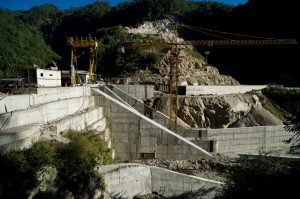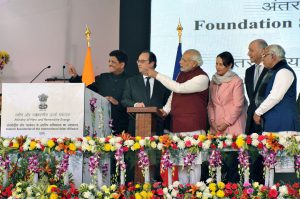China first announced its ambition to “go out” almost two decades ago, but the past year has seen a significant expansion in China’s overseas engagement. In supporting new financial institutions, such as the Asian Infrastructure Investment Bank (AIIB) and the Shanghai-based New Development Bank (known as the “BRICS Development Bank”) and announcing significant trade, investment and resources extraction initiatives under the “One Belt, One Road” strategy, China has challenged the so-called Bretton Woods system.
As I noted elsewhere on chinadialogue, the former reflects the lack of progress in expanding China’s role in international organisations, such as the World Bank and IMF, which appear increasingly unrepresentative. The latter – which seeks to build connectivity and cooperation across Eurasia (the “Silk Road Economic Belt”) and an expanding network of sea lanes (the “21st-century Maritime Silk Road”) – suggests not only a newly assertive foreign policy, but also a desire to shift some of China’s overcapacity to new markets in the “new normal”: a period of slowing growth that China hopes will see a structural shift towards higher-quality, sustainable development.
In this changing context, a new, special edition of our journal collecting the best of our writing on these topics, available here for free download, presents a range of important perspectives on how China’s activities in financing development, building infrastructure and extracting resources are changing around the world, and how these experiences are, in turn, starting to change Chinese approaches to development.
Beyond the oft-repeated rhetoric of “win-win” cooperation, the environmental aspects of China’s rise often remain under-reported – and thus require greater attention at this critical juncture. The reporting and analysis in this special issue explain how Chinese capital continues to support coal-fired generation around the world, from eastern Europe to Pakistan; how Chinese companies are implicated in unsustainable and often illegal deforestation from Mozambique to Brazil and Guyana; how fuel subsidies support overfishing by Chinese distant water fishing fleets; how extractives-led development sustains conflict in Afghanistan; and why Chinese funded dams in Mongolia might call the “green Silk Road” into question.
But the articles in this issue also bring to light new possibilities: that the AIIB, for example, might embrace international lending standards and welcome NGO participation to an unexpected degree, even while its lack of a resident board presents a challenge; that energy companies may be engaging with civil society overseas to improve their reputation and security; that Chinese companies may embrace new voluntary standards of best practice; and perhaps most promisingly, that Chinese investment might speed the low-carbon transition around the world.
Indeed, China could change the game – and remake the map – for the better, as thanks to sustained investment in renewable energy technologies, the country emerges as world leader in manufacturing and innovating the products needed to generate electric power from the wind and the sun, which leading innovation scholars John Mathews and Hao Tan recently concluded may mark the beginning of “a new energy paradigm with epochal implications.”
In Pakistan’s Punjab, Zofeen Embrahim reports on the Chinese company building a 100-megawatt solar photovoltaic farm, the first energy project under the US$46 billion China-Pakistan Economic Corridor, and the pilot stage of a plan to build the world’s largest solar farm. We also explored how major Chinese food importers might play an important role in the fight against deforestation in Latin America by committing to supply their domestic market with sustainably sourced soya.
In the context of global efforts to mitigate climate change after the Paris accord, and China’s renewed drive to create an “ecological civilisation” at home, understanding these examples becomes only more important. We hope the articles in this special issue will advance that understanding.
Follow this link to read the report ‘China remakes the map: Green Perspectives’, sponsored by the Henry Luce Foundation.








